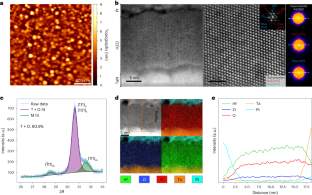2023-9-14 オークリッジ国立研究所(ORNL)
◆この研究により、ハフニアの表面層の挙動を大気の変化によって調整でき、材料の特性を変更することが示唆されました。将来の研究では、ハフニアを他の元素と合金化した場合の挙動も予測できるかもしれません。この発見は、半導体産業における材料のデバイスエンジニアリングに影響を与える可能性があります。
<関連情報>
- https://www.ornl.gov/news/scientists-uncovered-mystery-important-material-semiconductors-surface
- https://www.nature.com/articles/s41563-023-01619-9
ハフニアにおける強誘電性が表面電気化学状態によって制御される Ferroelectricity in hafnia controlled via surface electrochemical state
Kyle P. Kelley,Anna N. Morozovska,Eugene A. Eliseev,Yongtao Liu,Shelby S. Fields,Samantha T. Jaszewski,Takanori Mimura,Sebastian Calderon,Elizabeth C. Dickey,Jon F. Ihlefeld & Sergei V. Kalinin
Nature Materials Published:14 August 2023
DOI:https://doi.org/10.1038/s41563-023-01619-9

Abstract
Ferroelectricity in binary oxides including hafnia and zirconia has riveted the attention of the scientific community due to the highly unconventional physical mechanisms and the potential for the integration of these materials into semiconductor workflows. Over the last decade, it has been argued that behaviours such as wake-up phenomena and an extreme sensitivity to electrode and processing conditions suggest that ferroelectricity in these materials is strongly influenced by other factors, including electrochemical boundary conditions and strain. Here we argue that the properties of these materials emerge due to the interplay between the bulk competition between ferroelectric and structural instabilities, similar to that in classical antiferroelectrics, coupled with non-local screening mediated by the finite density of states at surfaces and internal interfaces. Via the decoupling of electrochemical and electrostatic controls, realized via environmental and ultra-high vacuum piezoresponse force microscopy, we show that these materials demonstrate a rich spectrum of ferroic behaviours including partial-pressure-induced and temperature-induced transitions between ferroelectric and antiferroelectric behaviours. These behaviours are consistent with an antiferroionic model and suggest strategies for hafnia-based device optimization.



